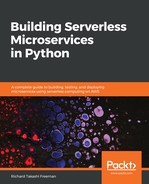Some key serverless services in AWS are explained in the following list:
- Amazon Simple Storage Service (S3): A distributed web-scale object store that is highly scalable, highly secure, and reliable. You only pay for the storage that you actually consume, which makes it beneficial in terms of pricing. It also supports encryption, where you can provide your own key or you can use a server-side encryption key provided by AWS.
- Amazon DynamoDB: A fully-managed NoSQL store database service that is managed by AWS and allows you to focus on writing the data out to the data store. It's highly durable and available. It has been used in gaming and other high-performance activities, which require low latency. It uses SSD storage under the hood and also provides partitioning for high availability.
- Amazon Simple Notification Service (SNS): A push-notification service that allows you to send notifications to other subscribers. These subscribers could be email addresses, SNS messages, or other queues. The messages would get pushed to any subscriber to the SNS service.
- Amazon Simple Queue Service (SQS): A fully-managed and scalable distributed message queue that is highly available and durable. SQS queues are often subscribed to SNS topics to implement the distributed publish-subscribe pattern. You pay for what you use based on the number of requests.
- AWS Lambda: The main idea is you write your business logic code and it gets triggered based on the event sources you configure. The beauty is that you only pay for when the code is actually executed, down to the 100 milliseconds. It automatically scales and is highly available. It is one of the key components to the AWS serverless ecosystem.
- Amazon API Gateway: A managed API service that allows you to build, publish, and manage APIs. It performs at scale and allows you to also perform caching, traffic throttling, and caching in edge locations, which means they're localized based on where the user is located, minimizing overall latency. In addition, it integrates natively with AWS Lambda functions, allowing you to focus on the core business logic code to parse that request or data.
- AWS Identity and Access Management (IAM): The central component of all security is IAM roles and policies, which are basically a mechanism that's managed by AWS for centralizing security and federating it to other services. For example, you can restrict a Lambda to only read a specific DynamoDB table, but not have the ability to write to the same DynamoDB table or deny read/write access any other tables.
- Amazon CloudWatch: A central system for monitoring services. You can, for example, monitor the utilization of various resources, record custom metrics, and host application logs. It is also very useful for creating rules that trigger a notification when specific events or exceptions occur.
- AWS X-Ray: A service that allows you to trace service requests and analyze latency and traces from various sources. It also generates service maps, so you can see the dependency and where the most time is spent in a request, and do root cause analysis of performance issues and errors.
- Amazon Kinesis Streams: A steaming service that allows you to capture millions of events per second that you can analyze further downstream. The main idea is you would have, for example, thousands of IoT devices writing directly to Kinesis Streams, capturing that data in one pipe, and then analyzing it with different consumers. If the number of events goes up and you need more capacity, you can simply add more shards, each with a capacity of 1,000 writes per second. It's simple to add more shards as there is no downtime, and they don't interrupt the event capture.
- Amazon Kinesis Firehose: A system that allows you to persist and load streaming data. It allows you to write to an endpoint that would buffer up the events in memory for up to 15 minutes, and then write it into S3. It supports massive volumes of data and also integrates with Amazon Redshift, which is a data warehouse in the cloud. It also integrates with the Elasticsearch service, which allows you to query free text, web logs, and other unstructured data.
- Amazon Kinesis Analytics: Allows you to analyze data that is in Kinesis Streams using structured query language (SQL). It also has the ability to discover the data schema so that you can use SQL statements on the stream. For example, if you're capturing web analytics data, you could count the daily page view data and aggregate them up by specific pageId.
- Amazon Athena: A service that allows you to directly query S3 using a schema on read. It relies on the AWS Glue Data Catalog to store the table schemas. You can create a table and then query the data straight off S3, there's no spin-up time, it's serverless, and allows you to explore massive datasets in a very flexible and cost-effective manner.
Among all these services, AWS Lambda is the most widely used serverless service in AWS. We will discuss more about that in the next section.
